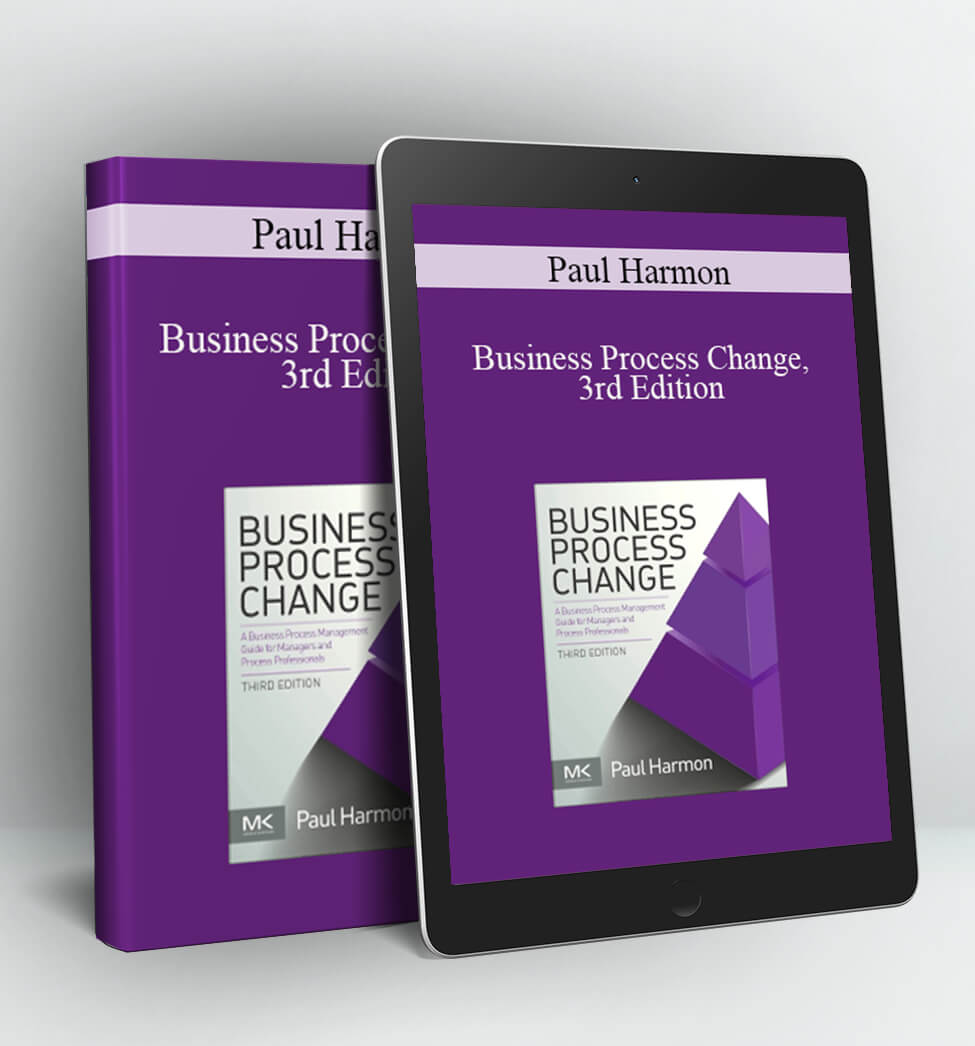
Business Process Change, 3rd Edition – Paul Harmon
Business Process Change, 3rd Edition
Business Process Change, 3rd Edition provides a balanced view of the field of business process change. Bestselling author Paul Harmon offers concepts, methods, cases for all aspects and phases of successful business process improvement. Updated and added for this edition is new material on the development of business models and business process architecture development, on integrating decision management models and business rules, on service processes and on dynamic case management, and on integrating various approaches in a broad business process management approach.
New to this edition:
- How to develop business models and business process architecture
- How to integrate decision management models and business rules
- New material on service processes and on dynamic case management
- Learn to integrate various approaches in a broad business process management approach
Key Features
- Extensive revision and update addresses Business Process Management Systems, and the integration of process redesign and Six Sigma
- Learn how all the different process elements fit together in this best first book on business process, now completely updated
- Tailor the presented methodology, which is based on best practices, to your organization’s specific needs
- Understand the human aspects of process redesign
- Benefit from all new detailed case studies showing how these methods are implemented
Readership
Process practitioners (managers, business analysts, business process architects); students in BPM programs, some Lean and Six Sigma professionals, some IT practitioners
Table of Contents
- Dedication
- Foreword
- Preface to the Third Edition
- Introduction
- Chapter One. Business Process Change
- Organizations as Systems
- Systems and Value Chains
- The Six Sigma Movement
- Business Process Change in the 1990S
- Lean and the Toyota Production System
- Other Process Change Work in the 1990S
- A Quick Summary
- Business Process Change in the New Millennium
- What Drives Business Process Change?
- Notes and References
- Part I. Organization-Wide Concerns
- Introduction
- Chapter Two. Strategy, Value Chains, Business Initiatives, and Competitive Advantage
- Defining a Strategy
- Porter’s Model of Competition
- Industries, Products, and Value Propositions
- Strategies for Competing
- Porter’s Theory of Competitive Advantage
- Porter’s Strategic Themes
- Treacy and Wiersema’s Positioning Strategies
- The Balanced Scorecard Approach to Strategy
- Business Models
- Business Initiatives
- Summary
- Notes and References
- Chapter Three. Understanding Your Organization
- A Comprehensive Business Process Method
- Strategy and Enterprise BPM
- Understand the Enterprise
- The Traditional View of an Organization’s Structure
- A Case Study of Organization Transformation
- The Systems View of an Organization
- Models and Diagrams
- Organization Diagrams
- Organizations and Value Chains
- Systems and Processes
- Notes and References
- Chapter Four. Business Architecture
- The Supply Chain Council’s SCOR Framework
- Business Architecture: The IT Approach
- Business Process Architecture
- Defining an Architecture Using a Framework
- The Supply Chain Council’s SCOR Framework
- Developing a Supply Chain Architecture with SCOR
- The Extension of SCOR
- Another Approach
- Summary
- Notes and References
- Chapter Five. Measuring Process Performance
- Key Measurement Terms
- Developing a Comprehensive Measurement System
- Balanced Scorecard and Process Measures
- Aligning Process Measures
- Deriving Measures from Business Process Frameworks
- Putting It All Together
- Completing the Business Process Architecture Worksheet
- Notes and References
- Chapter Six. Process Management
- The Process Perspective
- What is Management?
- Matrix Management
- The Management of Outsourced Processes
- Value Chains and Process Standardization
- Management Processes
- Documenting Management Processes in an Architecture
- Completing the Business Process Architecture Worksheet
- Notes and References
- Chapter Seven. An Executive Level BPM Group
- What Does a BPM Group Do?
- Create and Maintain the Enterprise Business Process Architecture
- Identify, Prioritize, and Scope Business Process Change Projects
- Help Create, Maintain, and Manage the Process Performance System
- Help Create and Support the Process Manager System
- Recruit, Train and Manage Business Process Change Professionals
- Manage Risk/Compliance Reporting and Documentation
- A Case Study: Boeing’s GMS Division
- Summary
- The BPM Group
- Notes and References
- Part II. Process Level Concerns
- Introduction
- Chapter Eight. Understanding and Scoping Process Problems
- What is a Process?
- Process Levels and Levels of Analysis
- Simple and Complex Processes
- Business Process Problems
- The Initial Cut: What is the Process?
- Refining an Initial Process Description
- Creating a Business Case for a Process Change Project
- Notes and References
- Chapter Nine. Modeling Business Processes
- Process Flow Problems
- Day-to-Day Management Problems
- Process Flow Diagrams
- Flow Diagramming Basics
- More Process Notation
- As-Is, Could-Be, and To-Be Process Diagrams
- Case Management
- Notes and References
- Chapter Ten. Human Performance Analysis, Automation, and Decision Management
- Analyzing a Specific Activity
- Analyzing Human Performance
- Managing the Performance of Activities
- Automating the Enter Expense Reports Activity
- Empowering Employees
- Analyzing a Completely Automated Activity
- Decision Management
- Knowledge Workers, Cognitive Maps, and Decision Management
- Notes and References
- Chapter Eleven. Managing and Measuring a Specific Business Process
- Representing Management Processes
- The Management Process
- Plan Work
- Organize Work
- Communicate
- Control Work
- Evaluating the Performance of the Process Manager
- Continuous Measurement and Improvement
- Management Redesign at Chevron
- Notes and References
- Chapter Twelve. Incremental Improvement with Lean and Six Sigma
- Six Sigma
- The Six Sigma Concept
- The Six Sigma Approach to Process Improvement
- Phases in a Six Sigma Improvement Project
- Lean
- Summary
- Notes and References
- Chapter Thirteen. The BPTrends Process: Redesign Methodology
- Why Have a Methodology?
- How Does it All Begin?
- What Happens?
- Who Makes it All Happen?
- Phase 1: Understanding the Project
- Phase 2: Analyze Business Process
- Phase 3: Redesign Business Process
- Phase 4: Implement Redesigned Process
- Phase 5: Roll Out the Redesigned Process
- Summary
- Notes and References
- Chapter Fourteen. The Rental Cars-R-Us Case Study
- Rental Cars-R-Us
- Phase 1: Understand the Project
- Phase 2: Analyze the Business Process
- Phase 3: Redesigning the Rental Process
- Phase 4: Implement the Redesigned Business Process
- Phase 5: Roll Out the New Rental Process
- Notes and References
- Part III. Implementation Level Concerns
- Introduction
- Chapter Fifteen. Software Tools for Business Process Analysis and Design
- Why Use Business Process Software?
- The Variety of Business Process Tools
- A Professional BP Modeling Tool
- Notes and References
- Chapter Sixteen. Business Process Management Suites
- Process Diagrams and BPMS Engines
- What Features Might a BPM Suite Include?
- BPMS and BAM
- BPMS, SOA, and the Cloud
- Choosing a BPMS Product
- The Current BPMS Market
- Some Leading BPMS Vendors
- Market Trends
- Process Modeling Tools vs BPMS Suites
- Creating a BPMS Application
- Notes and References
- Chapter Seventeen. ERP-Driven Redesign
- Processes, Packages, and Best Practices
- A Closer Look at SAP
- Implementing an ERP-Driven Design
- Case Study: Nestlé USA Installs SAP
- Using BPMS to Improve ERP Installations
- Enterprise Resource Planning and Business Process Management Suite
- ERP vs BPMS Applications
- Notes and References
- Chapter Eighteen. The Future of Business Process Management
- Appendix 1. Business Problem Analysis Checklist
- Appendix 2. Core Business Process Modeling Notation
- Appendix 3. Business Process Standards
- Index
Details
- No. of pages: 520
- Language: English
- Copyright: © Morgan Kaufmann 2014
- Published: 26th April 2014
- Imprint: Morgan Kaufmann
- Paperback ISBN: 9780128003879
- eBook ISBN: 9780128005224
About the Author
Paul Harmon
Paul Harmon is a cofounder and executive editor at Business Process Trends, an internationally popular website that provides a variety of free articles, columns, surveys and book reviews each month on trends, directions, and best practices in business process management. He is also a cofounder, chief methodologist, and principal consultant of BPTrends Associates, a professional services company providing executive education, training, and consulting services for organizations interested in understanding and implementing business process management. At the same time Mr. Harmon serves as a Senior Consultant for AI with Cutter Consortium.
Affiliations and Expertise
Enterprise Alignment, San Francisco, CA, USA
Access Download Business Process Change, 3rd Edition – Paul Harmon right now!
Delivery Method:
After your purchase, you’ll get access to the downloads page. Here, you can download all the files associated with your order.
Downloads are available once your payment is confirmed, we’ll also send you a download notification email separate from any transaction notification emails you receive from Coursedownloads.




